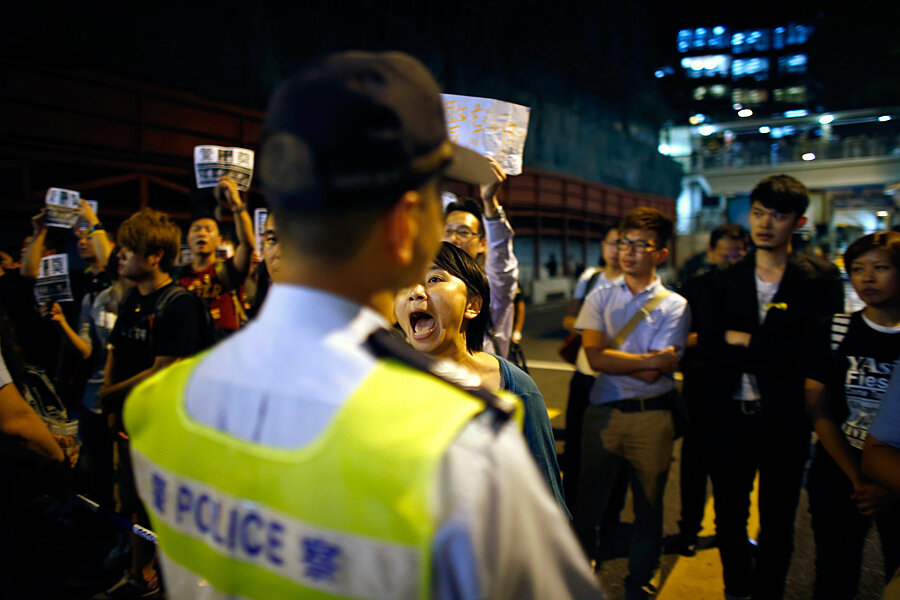Video of Hong Kong police beating riles protest movement
Loading...
A daily roundup of terrorism and security issues.
The apparent police beating of a Hong Kong pro-democracy protester has compounded tensions in the 18-day standoff between citizens and Hong Kong authorities at a time when the demonstrations were slowing.
A video, aired on local television station TVB, shows several plainclothes officers dragging a handcuffed protester into a dark corner, where he is kicked and beaten. The protester was later identified as Len Tsang, a member of the Civic Party and a social worker in Hong Kong. His face, neck, back, and arms were covered in bruises, according to The Telegraph.
The incident went viral, sparking outrage.
“This is certainly an abuse of police power in every sense of the word,” Alan Leong, head of the Civic Party, told the Financial Times.
The footage could help reinvigorate protesters demanding the right to choose their own candidates for Hong Kong's top political position, the chief executive. At the end of August Beijing announced that the Communist Party will vet those candidates which many in Hong Kong see as a broken promise. Protests that started in September have dwindled to just a few hundred participants in recent days, many of them students, from the tens of thousands that turned out earlier.
Police have worked since Monday to shrink the area occupied by demonstrators in the city's main financial district – breaking down barricades and removing other barriers, usually in the early morning hours when protester turnout was lowest, to allow traffic to return to normal.
Overnight, before the video taped beating allegedly took place, demonstrators chanted pro-democracy slogans and blocked traffic in a tunnel in the central Admiralty district. The Associated Press reports police officers, using riot shields and batons, “knocked activists to the ground, dragging dozens away, and tore down barricades protesters used as roadblocks around the underpass outside the government’s headquarters.”
Police say they arrested some 45 protesters overnight, using pepper spray to help disperse crowds that had flocked to the tunnel.
Hong Kong police put out a statement saying they will conduct an investigation into the alleged beating and that the six officers implicated in the incident were temporarily removed from their positions. It’s an embarrassment for the police force, which has long enjoyed an excellent reputation in the region, reports the Los Angeles Times:
…[S]ince the unprecedented street protests erupted in late September, the force has faced criticism for initially using tear gas against protesters, and allegations of collusion with gang members seeking to intimidate the demonstrators. Outrage over the use of tear gas – an exceptionally rare event in Hong Kong – spurred many Hong Kongers to join the protests.
Leaders of the force have defended their decision to use tear gas, saying they feared the protests might lead to a stampede or a similarly dangerous situation. They have denied any links to criminal gangs.
But with the demonstrations now in their third week, stress has sapped morale among the force, according to Junior Police Officers’ Assn. chairman Joe Chan Cho-Kwong.
"We start to be unable to distinguish right and wrong,” the police union chief said in an interview with the South China Morning Post.
For Hong Kongers who want full and free democracy that would ensure more freedom in the future, the taped beating may be seen as an example of their rights at risk. “If we don’t demonstrate, I’m afraid that China will take away our freedom in a couple of years,” Jenny Chan, a student nurse, told The Christian Science Monitor last week as she handed out water to fellow demonstrators.
Beijing is keen to see the protests end. An editorial in the government mouthpiece The People’s Daily described the Hong Kong protests as “doomed to fail.”
Facts and history tell us that if we surrender to political extortion when some people start radical and illegal acts then it will only bring more severe illegal activities, exacerbating disorder and turmoil and there will never be any peace in society.
"Stability is bliss, and turmoil brings havoc," the editorial said.








